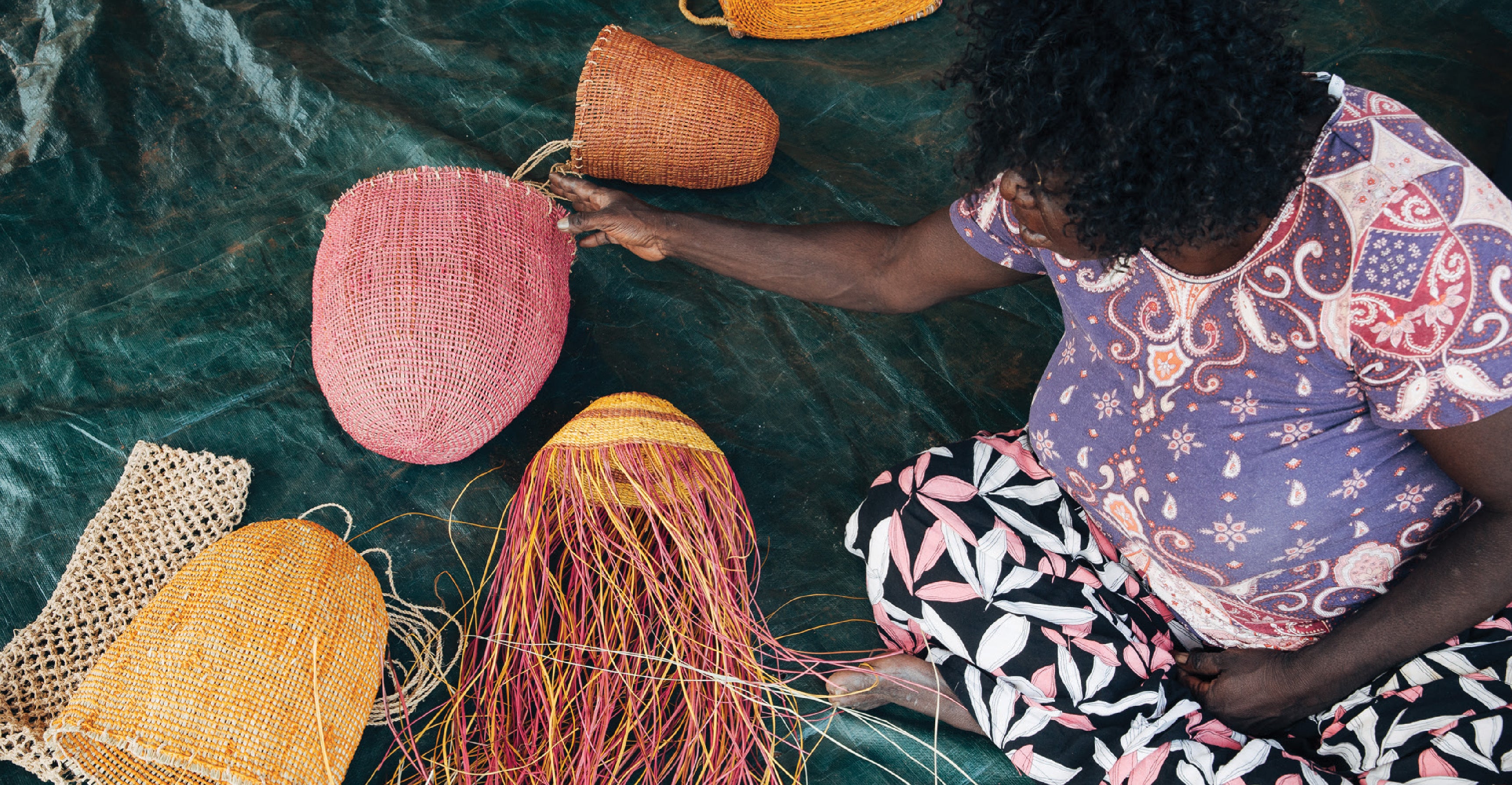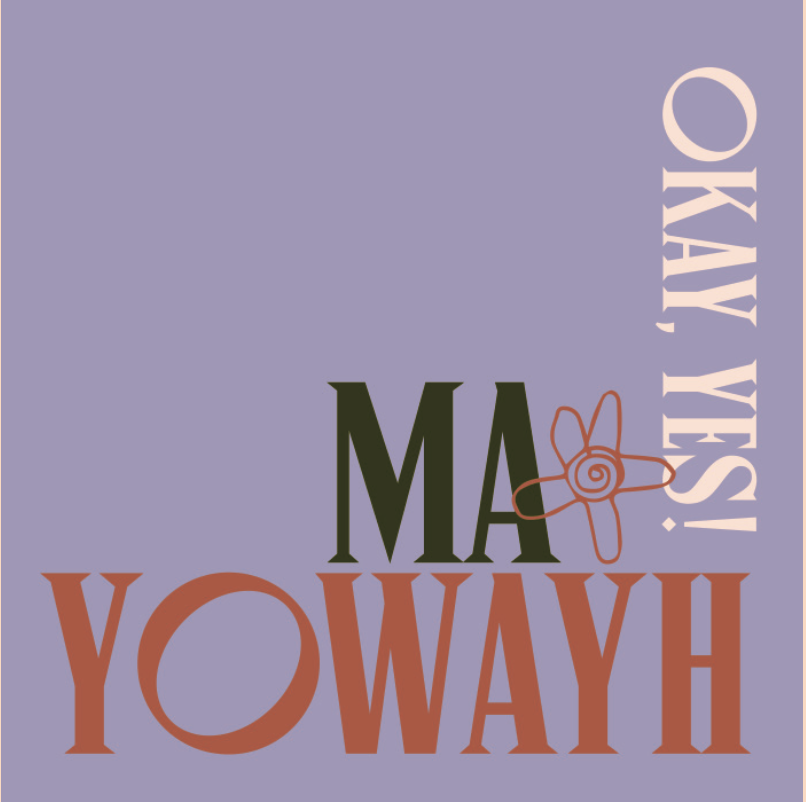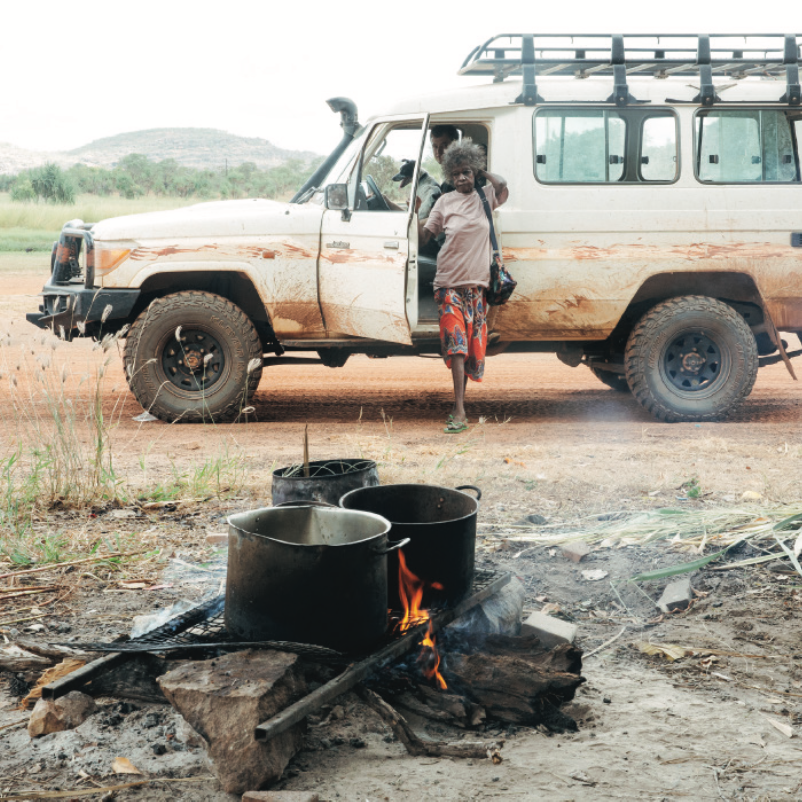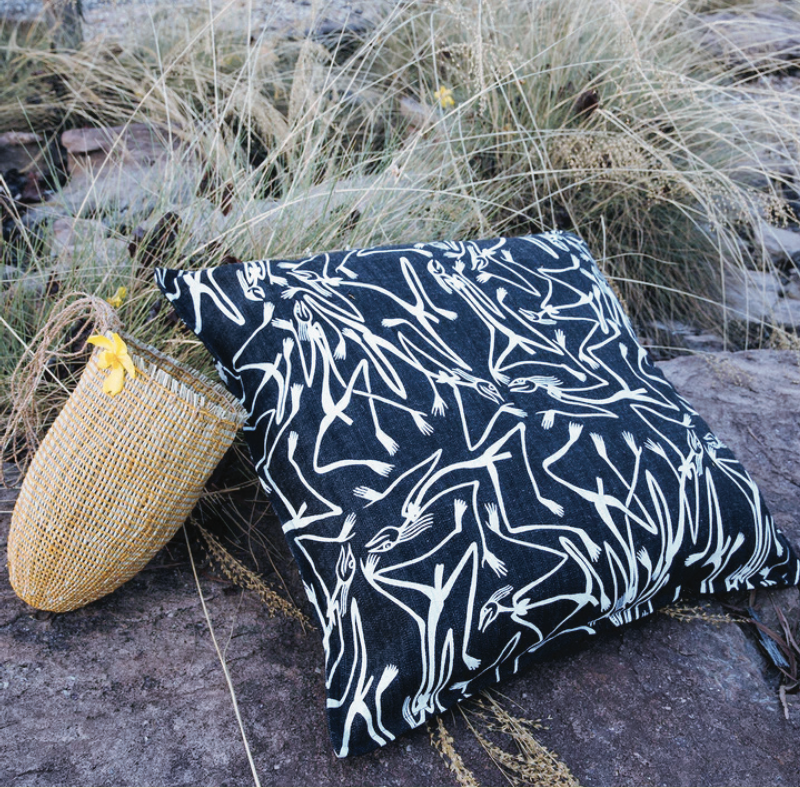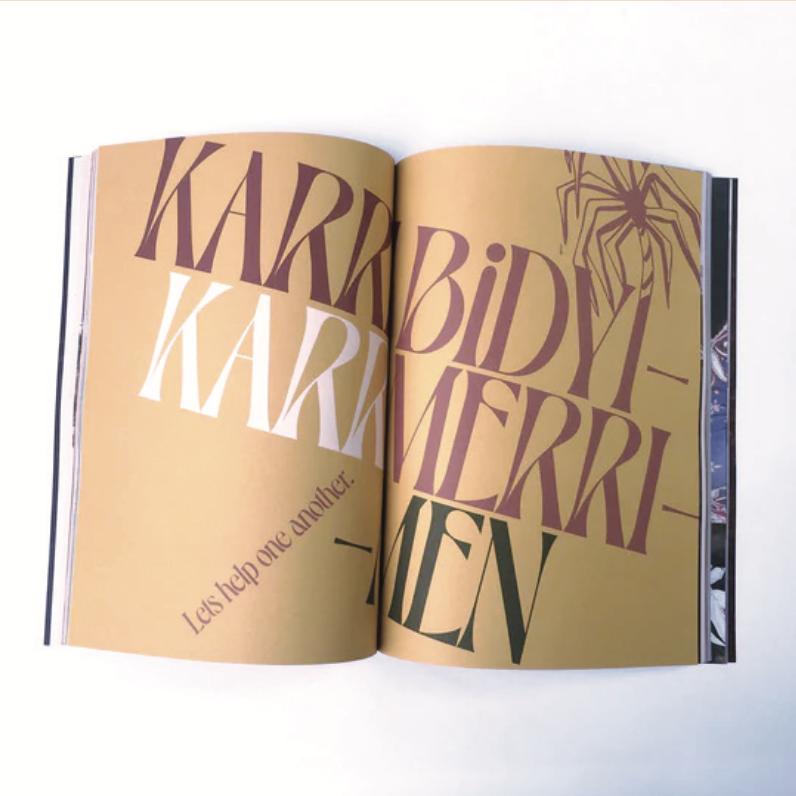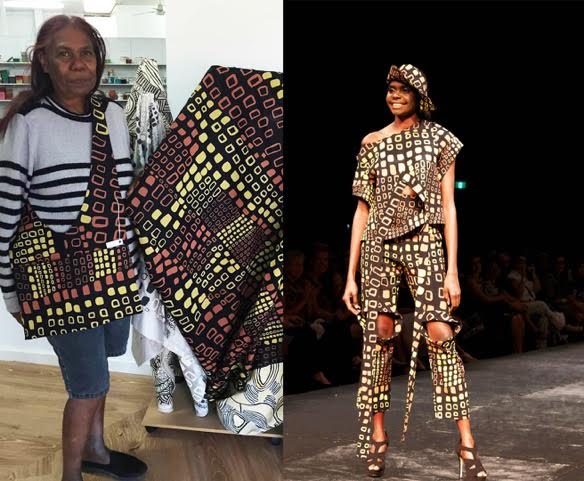Skip to content
Journal

Kieren Karritpul
Renowned artist from Merrepen Arts Centre, featured NORTH artist
- 1st March 2017 -

You come from a long line of inspirational artists, what is your earliest memory of creating art?
When I was six, six years old. My mum, aunties and brother were all painting and I was hanging around at the art centre.
Can you tell us about the hand screen-printing process that happens at Merrepen and what it means to have everyone involved?
They use to do it before, but then they stopped. Then we started doing it in 2011 or 2012. They first started along time ago, before I was born. It’s good to have people come together again. I enjoy both printing and painting. We usually print five runs of eight metres per day.
The fishnet is a reoccurring story within your work, we know that it is traditionally used by older women to collect fish and turtles and is hand made by women from Merrepen. What significance does painting the fishnet have to you? Why do you paint the fishnet design?
When I was young I used to go out with my mum, grandma and my great, great grandmother and other older ladies, and I used to watch them getting Merrepen and different colours and then they used to do the fishnet, and I remember when I was kid we used to go to the creek and they used it to get bait fish. Near the community there’s a billabong, but theres a little creek there and we used it to get bait fish or barramundi. That's why I paint the fish net.
If there was one celebrity you would dream of seeing in a fishnet dress or suit, who would this lucky person be?
Maybe the Queen or maybe Barak Obama’s wife.
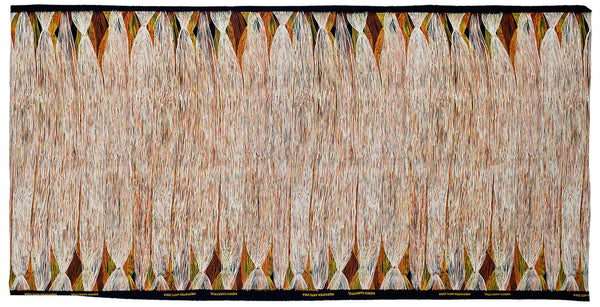 Yerrgi, 2014. The winner of the 'Youth Award' at the National Aboriginal & Torres Strait Islander Art Award 2014 is Kieren Karritpul for 'Yerrgi' - Acrylic on cotton.
Yerrgi, 2014. The winner of the 'Youth Award' at the National Aboriginal & Torres Strait Islander Art Award 2014 is Kieren Karritpul for 'Yerrgi' - Acrylic on cotton.




Delores Tipuamantumirri
Renowned artist from Melville Island Delores and her grand daughter Dakota
- 18th January 2017 -

Tell us a bit about your paintings, what techniques and colors do you tend to use and what are their significance to you and the Tiwi Islands?
Dolla - The painting I’m doing now is about a net, a fish net. Banapa they call it. I use red, yellow and white. I use the red and yellow first and the white over it. I use a big wooden comb.
- These colours come from ochre. The ochre is the yellow and white. The yellow and white orche gets collected from the beach and when the yellow ochre is cooked on a fire it turns to red.The wooden comb, called a powja is used to apply paint and create the aesthetic of the fishnets used for hunting in Tiwi. -
Your mother Cornelia is a respected elder and artist in Tiwi and also a featured artist of North’s - how has she influenced you and your work?
Dolla - She’s an elder from Tiwi, she has influenced me just recently. My mother and my grandfather would paint together, so I joined them. I started painting after her (Cornelia), maybe in 2012 or 2013 I’d say.
Do you think this artistic skill and knowledge will continue to be passed on in your family and to the younger generations?
Dolla - My grand-daughter’s Shanon and that do painting too, she’ll be 12 and she’ll be going to a MITS a in Richmond.
Dakota -That’s the Melbourne Indigenous Transition School. A group of kids come down with one of the house keepers.. They go to Richmond High and after one year when they graduate from MITS they go to a private school after
Only Des and Shannon are the artistic children in the whole family. Me and Des did this painting competition thing, where there were like heaps and heaps of kids that did this painting for a postcard and Des was the one who won. He did this turtle design with red, black and yellow with dots and lines and a turtle. Somewhere in Australia they sell those postcards with the painting on it.
- Dakota is fantastic at sports including athletics and football! -
We know that your artwork is about to be exhibited in Singapore – How exciting! Can you tell us a bit about the exhibition and the artwork that will be shown?
Dolla - There’s about 3 paintings going to Singapore. But I don’t know about Mum, I don’t know how much painting she got. Mines a pretty big one, and two middle size.
What are you going to do if you sell a big piece?
Dolla - Ill give half to my family. To the kids.
What do you love most about life on the Tiwi Islands?
Dolla - Going out in the bush. Camping. Hunting. Fishing. Hunting for mud mussel, the longbum – it’s like a snail, you find them on the mud, on the beach but the other one you got to look inside the log, see half of their shell in there in the mud.
Do you like longbum Dakota?
Dakota – Yeh, but its hard to crack. Only mud mussels. Once it cooks inside you just put it on something hard and get a rock and you just crack it open and take it out. Its green and black. Yeh, it’s really nice. OH! But have you guys ever ate a snake before? Carpet snake?!..
What do you love about the Tiwi Islands Dakota?
Dakota – But the best thing about going to Tiwi Islands is you get away from all the city and everything, you get away from the city and like heaps of technology and trams and everything, all there is just bush and cars, just a tiny bit of cars, and just heaps of sea and you go hunting and camping, you cant really go hunting here in Melbourne. You can only go hunting for like shoes and clothes.
This one time in the afternoon when we were at Tiwi Islands, this dog started barking at a tree so we all went there and we saw that it wasn’t a snake or anything, it was a baby, sugar glider, so I picked it up and took care of it for the whole time we were there, and then so when we went back to Darwin, I gave it to my cousin Duan and he’s still got her now. He’s still got her and he named her Roxy. They’re so cute, their eyes are so adorable.
What has been a highlight since you’ve started painting?
Dolla - Last year my painting went to Paris, someone bought it and put it on Facebook, they showed me.
- One of Delores's paintings was purchased last year by a resident of Paris and hung in their home. Photos of the work hanging were posted on Facebook and shared with her and the community. This was a very proud moment for Dolla -
Interview By: Monica Segovic




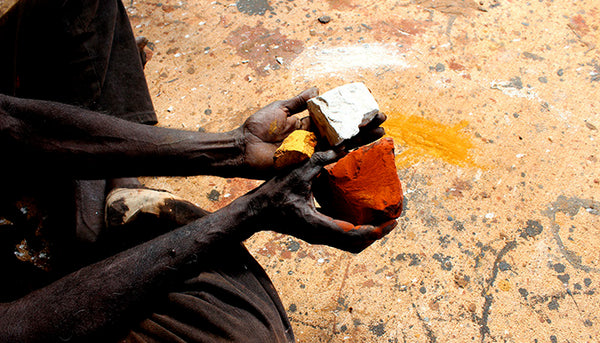


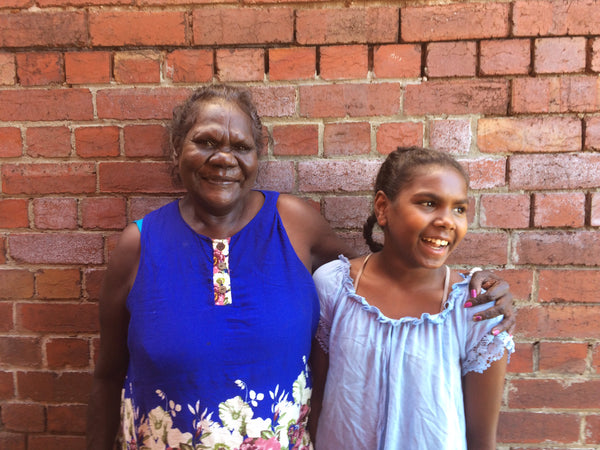
Bobbie Ruben
Textile Designer & Printmaker, running workshops on community and assisting artists in creating designs for screen printed textiles
- 21st December 2016 -

Having worked within the printmaking and textile design industry for a long time, can you give us a brief outline of what you have achieved and some highlights of your career?
Since finding this work in the early 2000s I have worked with mostly remote community Indigenous artists in the development of over 250 large-format repeat textile designs along with numerous editions of fine art prints on paper.
A highlight has been my involvement in many of the growing number of exhibitions and events featuring the textiles, especially where they have been hung in vast 8M lengths on both the inside and exteriors of public buildings and art galleries. Who could forget the excitement of seeing Merrepen textiles winning Melbourne cup ‘Fashion on the field’ in 2013, or Merrepen textiles being personally gifted to Prince William and the Duchess of Cambridge in 2014 and later that year entering and winning the youth section of the Telstra National Aboriginal and Torres Strait Islander Art Award. Seeing the many instances of these beautiful and dynamic textiles incorporated in high-end furnishings has also been a great opportunity.
Another significant highlight has been my involvement in Indigenous fashion performances that have celebrated and promoted the textiles. In these exciting and much anticipated events Indigenous culture is emphasized more so than expressing a desire to enter into the fashion industry.
This work draws on a cultural exchange in the design, production and usage of the textiles. It is affirming to see the nurturing of these exchanges and promotion of intercultural collaborative relationships integral to the future success of this movement.
Presently you are known to work closely with artists on community by assisting them in creating repeat print designs with their artwork. What does this entail?
The process begins by exploring with the artist their particular interests, the kind of imagery they usually create and what of these ideas would best translate to textile media. The artist then begins a series of sketches, which are redrawn onto a large sheet of paper corresponding with screen size. We usually work with a design area of around 1500mm x 800mm. Composition, balance, scale and working out how to repeat and join the image for textile design must all be considered. Once the drawing and design are finalized the artist then paints up this design onto separated film layers depending on how many colours will be printed. Problem solving, adjustments and reconfiguring of artwork continue in order to satisfy the constraints of the design process and reach the point where both the artist and myself are satisfied that it is going to be a beautiful and commercially successful textile design.
Photographing and preparing artwork for offsite printing, or exposing artwork onto screens for printing on community then follows. We often use Photoshop to explore colour options to enable the best possible combinations. Digital technology plays an increasing role in developing designs however it is only used as a tool rather than an end in itself, and at all stages the mark of the artists hand and the rawness and directness of the screen printing technique are retained.
Along with assisting in design work, my role can sometimes be as an intermediary between artists living in remote settings and the requirements of urban contemporary art and design markets.
How rewarding is it for the artists to be able to translate their work into a new medium?
As these textiles continue to gain national and international momentum and recognition, artists are able to gain a higher profile and recognition for their artwork and culture. Not only this but I see the joy and pride, determination to complete designs, and the sense of achievement in the finished work. Furthermore the artists can have a continuing relationship with their work once it has left the community, whether it is seeing their textiles worn in the street, in fashion performances, in interior design settings or in galleries and public spaces. The artists can also see the textiles in numerous print and electronic media. For artists happy to work within the design constraints and collaborative nature of textiles, the potential rewards are unlimited.
What initially drew you to where you are now and compelled the want to share your skills and knowledge in remote communities?
I love this work and feel lucky to be able to travel to incredible places and work closely with inspirational artists that I have had the pleasure of forming long term working relationships with.
While I bring skills and knowledge to workshops, in each workshop I also gain skills and knowledge through working with artists and colleagues. We learn from each other and all build skills and professional know-how together.
For me this work has organically gained momentum to the extent that I now wish to explore and understand the phenomenon of these incredible textiles via my research as a PhD candidate at James Cook University.
I find the work in textiles creates much excitement and draws a lot of different people to work together, from artists and designers, to arts workers and commercial enterprise. I like the fact that there is unlimited potential in this work that has as yet been barely uncovered. I also like that we will always need textiles and always need to create new and more beautiful designs.
In a dream scenario, where or in what form would you love to see the hand screen printed textiles exhibited?
My dream would be to see Australian Indigenous textiles treated as iconic Australian design and revered as Marimekko is to Finland. I would also like to see the textiles function as highly successful enterprises enabling full employment, travel and other opportunities for remote area Indigenous artists and arts workers.
What do you love most about visiting the Northern Territory?
Darwin had been my home for 22 years and I still feel I am coming home every time I return.
I love the edginess and otherness of Darwin culture and the rawness and wildness of the climate.
There is a freshness created by the revolving door of talent and enthusiasm that washes up on territory shores. Darwin as a community has a strong sense of itself and has evolved to suit its own local residents rather than as an attempt to attract visitors. The visitors come anyway because they like what we like.

Design workshop, Susan Marawarr, Babbarra Designs 2015. Photo: B. Ruben.
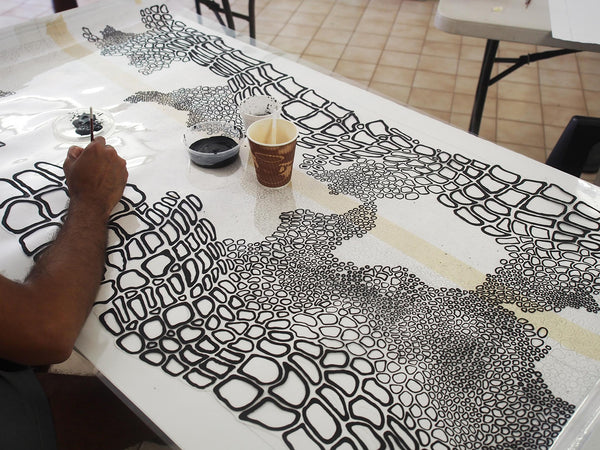
Design workshop, Aaron McTaggart, Merrepen Arts, Naiuyu Community 2016. Photo: B. Ruben.
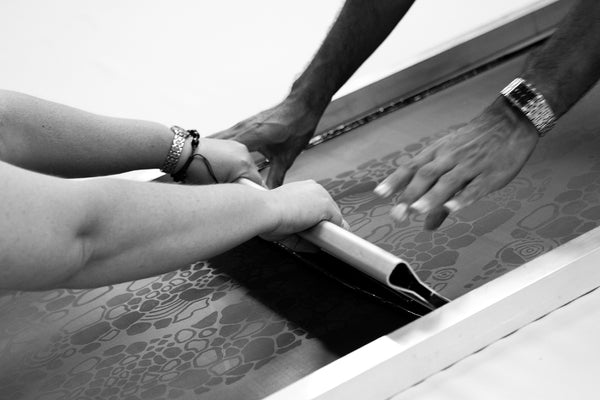
Hand-screen printing at Merrepen Arts Centre, Daly River. Photos by John Tsialos.

Hand-screen printing at Merrepen Arts Centre, Daly River. Photos by John Tsialos.

‘NgangiWetembi Dememarrgu’, textile exhibition, Merrepen Arts, Naiuyu Community 2014. Photos by John Tsialos.

‘NgangiWetembi Dememarrgu’, textile exhibition, Merrepen Arts, Naiuyu Community 2014. Photos by John Tsialos.
Maxine Charlie, Croc skin, Nagula Jarndu designs 2016.
Maminydjarma Maymuru, Darwin Aboriginal Art Fair fashion performance 2016.

Babbarra Designs textiles, Maningrida 2016. Photo: B. Ruben.
Bernadette Watt & Letoria Yulidjirri
from Anindilyakwa Arts Centre, Angurugu, Groote Eylandt
- 7th December 2016 -
You’re both artists and project officers here at Anindikyakwa Arts Centre. How did you first come to making art?
Bernadette - My brothers taught me back on Mornington Island where I grew up. I would watch how they did paintings of the Wurlywin Man, Brolga Lady, rats and squid. I still paint some of those stories now. I also did art at school here on Angurugu after moving here when I was 7 years old.
Letoria - I started coming in one day a week to do activities with Bernadette. She and the other lady taught me how to do dyeing and now I’m here a lot.
The Arts Centre has recently begun focussing on dyeing with materials from community and the bush. How did this come about?
Letoria - A woman called Aly de Groot comes here sometimes to teach the ladies how to do the dyeing. My favourite colours to dye with are red and yellow.
Bernadette - We go out and collect old steel, dig out plant roots for the yellow dye and collect other leaves to make the black colour. We then come back to the Arts Centre, crunch up the leaves and wrap the fabric tightly around bits of steel. We then boil up two billies, one with the yellow dye and another for black. When they have been in the dye long enough we wash them out and hang them to dry outside community.
We go out to Umbakumba community on the other side of the Eylandt, to Malkala (an outstation) and fly Milyakburra on Bikkerton Island to dye with other women. Sometimes we visit aged care too. The old ladies there like to do dyeing. Dyeing is good fun. It makes the women come together and chat while we dye. They really enjoy doing it.
It’s coming in to wet season now. What is wet season like on Angurugu?
Bernadette - I love wet season. The rivers run and when the sea comes in all the fish come in too. They breed in the rivers. It’s much better for fishing. You catch lots of fish and it’s much cooler out on the water. You can even spear stingray!
Letroia - I love wet season too!
If you could see anyone in the world wearing a scarf you’d created, who would it be?
Bernadette - Magnolia Maymuru, the model from Yirrkala who went to this Miss World competition. I met her at the Art Fair in Darwin last year. She was lovely.
Having lived in this remote part of the Northern Territory for most of your lives, what do you love most about living here?
Bernadette - I love living here in Angurugu. It’s a good place with friendly people you can look up to. It’s a nice place. My children grew up on Milyakburra, a community on Bikkerton Island just off the coast of Groote Eylandt. There are lots of lovely fishing spots around Groote Eylandt and Bikkerton Island. I also love working at the Arts Centre here, doing dying and screen printing. My latest design is the of the mud mussel which we collect in the mangroves.
Letoria - I grew up here. Most of my Mum’s family are here. It’s home.





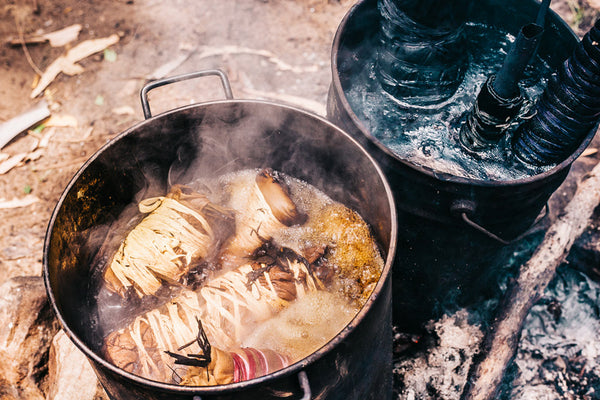
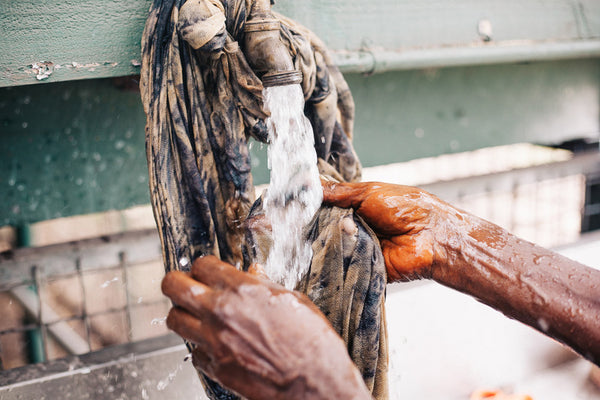




 Our journey
Our journey

